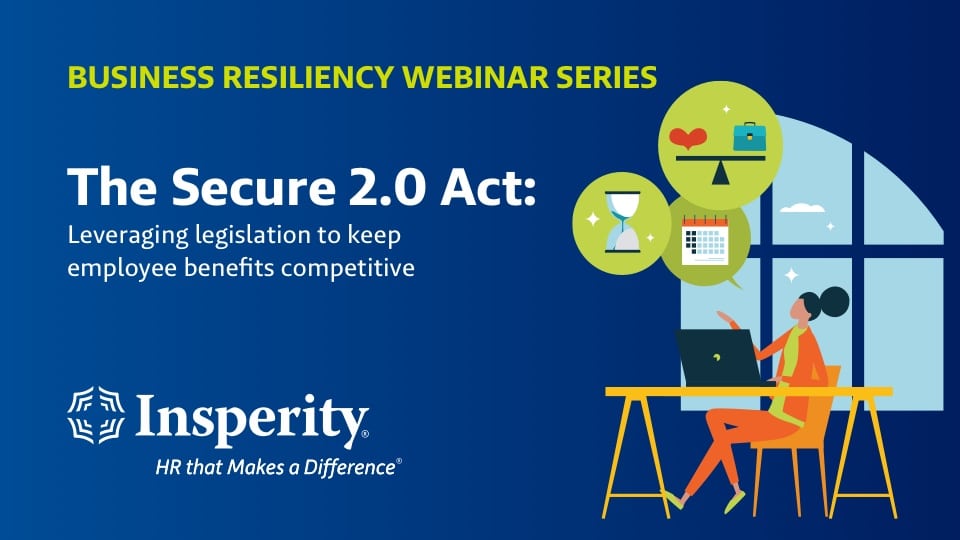SECURE 2.0 Key Provisions 2024
Some new retirement plan provisions went into effect on Jan. 1, 2024,
including changes to requirements for long-term and part-time
employee eligibility and SIMPLE plan limits.
New incentives to help grow Americans’ retirement savings
Enacted in December 2022, the SECURE 2.0 Act encourages Americans to save
for retirement and incentivizes employers to offer retirement plan benefits. It will
have an undeniable impact on businesses of all sizes in the coming years.
Watch the replay
The SECURE 2.0 Act:
Leveraging legislation to keep employee benefits competitive
View Insperity’s webinar on SECURE 2.0 for opportunities to gain a talent advantage by supporting your employees’ financial health beyond the basics of a 401(k) plan. From this in-depth discussion, discover how the legislation’s new provisions enhance your employee compensation strategy and learn ways to determine the features most important to your team.

What is SECURE 2.0?
- The SECURE 2.0 Act of 2022 is a law designed to improve retirement savings in the U.S. It builds on previous legislation, Setting Every Community Up for Retirement Enhancement (SECURE) Act of 2019.
- The Act contains over 90 new provisions to promote retirement savings, boost incentives for businesses to offer retirement plans and offer more flexibility to those saving for retirement.
- Some provisions are already in effect, while others will go into effect in 2024, 2025 and even later.
- Some provisions are required while others are optional for plan sponsors to provide.
Why is it important?
- SECURE 2.0 is important because it encourages and makes it easier for employees to save for retirement and incentivizes employers to offer retirement plan benefits.
- For employees, it increases catch-up contribution limits, increases the age for required minimum distributions, and expedites eligibility for long-term, part-time employees, among other enhancements.
- For small businesses, it includes tax credits for plan start-up costs and employer contributions.


Key provisions of the legislation
- Enhanced tax credit incentives for small businesses starting retirement plans
- Automatic 401(k) plan enrollment and escalation
- Expanded use of Roth contributions
- Increased age for required minimum distributions (RMDs)
- Increased catch-up contribution limits
- Expedited eligibility for part-time employees
- Expanded access to retirement savings including emergency savings
- Employer 401(k) match for student loan payments
- Federal saver’s matching program for low- to middle-income employees
Provisions going into effect Jan. 1, 2024
REQUIRED
Long-term, part-time employee eligibility
- Generally, 401(k) plans (and some 403(b) plans) cannot exclude long-term, part-time employees from deferring to the plan once they have completed at least 500 hours in each of three consecutive 12-month periods and are at least age 21. But plans may exclude them from receiving employer contributions. Beginning in 2025, the rule will require only two consecutive 12-month periods.
- Allows more employees to make contributions without requiring the employer to match those contributions.
SIMPLE plan limits
- For 2024, the general SIMPLE deferral limit increases to $16,000 and the catch-up limit remains $3,500. For SIMPLE plans of employers with 25 or fewer eligible employees, both limits are automatically 10% higher. Employers with 26-100 eligible employees may elect to provide the higher limits to their SIMPLE participants if they also make higher matching contributions (4%) or nonelective contributions (3%).
- The increased SIMPLE limits close the gap with the higher regular 401(k) plan limits for eligible participants.
OPTIONAL*
Student loan match
- Employers may choose to match in a retirement plan a participant’s student loan payments as if they were elective deferrals. The matching contributions must use the same rate, eligibility and vesting provisions as matching for elective deferrals.
- This allows employees to keep paying off student loans without missing out on matching contributions.
- Insperity continues evaluating this provision, while the industry awaits additional government guidance on implementation, so we will have more information in the future.
Emergency savings accounts (ESA)
- Plans may permit non-highly compensated employees (NHCEs) to have a an emergency savings account within the plan. Contributions must be Roth contributions and are capped at $2,500. The plan may automatically enroll NHCEs in the ESA at a rate up to 3% of compensation. The ESA must be invested only in a cash/principal preservation investment and allow at least one withdrawal per month (with no fees for the first four withdrawals per year).
- Permits employees to save with the knowledge they can access their account in an emergency without the 10% early withdrawal penalty.
- Insperity continues evaluating this provision, while the industry awaits additional government guidance on implementation, so we will have more information in the future.
Deferral-only starter plans
- Employers that do not maintain a qualified retirement plan may establish a starter 401(k) or 403(b) plan, which automatically satisfies nondiscrimination requirements. The plan must auto enroll employees at a uniform percentage between 3% to 15% (employees may opt out or change their percentage), permit only employee deferrals (i.e., no employer match or profit sharing) and limit deferrals to $6,000 per year with additional catch-up of $1,000.
- This new type of plan may appeal to the employer who wants to encourage retirement savings without having to make employer contributions to satisfy nondiscrimination requirements.
- Insperity continues evaluating this provision, while the industry awaits additional government guidance on implementation, so we will have more information in the future.
* As of December 2023, Insperity clients will not have access to these new, optional programs until the IRS provides more clarity about how each will function, which may not happen in 2024
Get a summary of the key provisions to the SECURE 2.0 Act
Frequently asked questions
What is SECURE 2.0?

The SECURE 2.0 Act was enacted on Dec. 29, 2022, and serves as a follow-up to the Setting Every Community Up for Retirement Enhancement (SECURE) Act of 2019. Both pieces of legislation are intended to address a perceived retirement readiness crisis by doing more to encourage retirement plan availability and participation. Some provisions went live the day the bill was signed, and others won’t be effective until 2024, 2025 and beyond. Some provisions are required, while others are optional.
Why is SECURE 2.0 important?

SECURE 2.0 is important because it encourages and makes it easier for employees to save for retirement and incentivizes employers to offer retirement plan benefits.
How is Insperity implementing required and optional provisions of SECURE 2.0?

Insperity has been reviewing SECURE 2.0 and evaluating next steps since the legislation was enacted. Many upcoming changes relate to payroll processes in support of retirement plan operations. As a result, much of Insperity’s efforts are focused – from a payroll perspective – on making the necessary modifications to our payroll systems to accommodate the new requirements. Additionally, Insperity Retirement Services has been making the necessary changes to its operational processes, procedures and technology. Finally, the Insperity Benefits Plan Committee continues to assess which optional SECURE 2.0 provisions to adopt in the Insperity 401(k) Plan.
How will Insperity communicate with clients about SECURE 2.0?

Insperity has been communicating with clients about relevant SECURE 2.0 provisions that are already in effect. Additional information on SECURE 2.0, who is impacted and what clients should be thinking about will be shared over the coming months. When appropriate action needs to be taken, Insperity will work with clients on implementation.
Where can I find detailed information about SECURE 2.0 provisions?

The SECURE 2.0 Key Provisions Summary reviews some of the provisions that may impact Insperity, our clients and employees. It includes a description, effective date, whether required or optional, and information specific to our client base.
Click to view Key Provisions SummaryWhat are some of the most discussed provisions of SECURE 2.0?

There are several provisions that have received a lot of attention by employers as well as legal and financial organizations. Below is an overview of some of the most talked-about provisions.
Enhanced plan startup tax credit for small businesses
Beginning in 2023, the startup plan tax credit increased to 100% of startup costs for small businesses with 1-50 employees (still 50% for employers with 51- 100 employees), and small businesses with 1-100 employees may also claim a tax credit for employer contributions for five years after startup.
Automatic enrollment requirement
For plan years beginning after 2024, any 401(k) or 403(b) plan established after Dec. 29, 2022, is required to automatically enroll eligible employees and implement automatic annual deferral increases.
Expanded catch-up contributions
Beginning in 2025, the annual catch-up contribution amount increases for participants ages 60-63.
Roth catch-up
Beginning in 2026, all catch-up contributions for participants earning more than $145,000 in the prior year must be made as Roth contributions.
Changes to required minimum distributions
The age requirement for participants to start taking required minimum distributions (RMDs) is increased from 72 to 73 in 2023, and age 75 in 2033. Beginning in 2023, penalties for not taking an RMD are reduced. Beginning in 2024, Roth contributions are not subject to RMD requirements during the participant’s lifetime.
Student loan matching contributions
Beginning in 2024, employers may match qualified student loan payments made by employees as if they were elective deferrals.
Expedited long-term, part-time employee eligibility
Eligibility for long-term, part-time employees to make 401(k) deferrals is expedited by shortening the eligibility period from three years to two years for plan years beginning after Dec. 31, 2024.
Emergency savings accounts
Beginning in 2024, plans may permit participants to make Roth contributions to an emergency savings account (ESA) in the plan of up to $2,500 maximum. Participants must be able to withdraw from the ESA at least once a month, and the 10% penalty for early withdrawal does not apply.
Deferral-only starter plans
Beginning in 2024, an employer that does not have a qualified retirement plan may establish a starter 401(k) or safe harbor 403(b) that permits only employee deferrals to automatically satisfy certain nondiscrimination testing requirements.
If I have questions, how do I get more information about SECURE 2.0?

Your plan’s third-party administrator (TPA) will be able to help you with questions about SECURE 2.0’s impact on your plan. If that TPA is Insperity Retirement Services, please contact your plan consultant in Insperity Retirement Services.
When will more information be available for SECURE 2.0?

Look for additional information to be shared as the effective dates of these changes approach.
What’s next?
Insperity is fully committed to working with our clients to ensure compliance with all provisions required under the SECURE 2.0 Act.
Stay tuned for resources and updates regarding provisions going into effect in the coming months and years.

